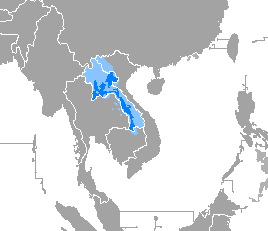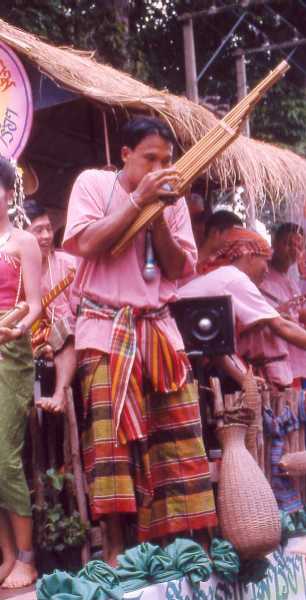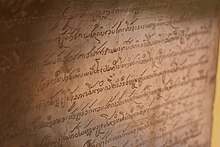
Thai, or Central Thai, is a Tai language of the Kra–Dai language family spoken by the Central Thai people, Mon in Central Thailand and the vast majority of Thai Chinese enclaves throughout the country. It is the sole official language of Thailand.
The Thai script is the abugida used to write Thai, Southern Thai and many other languages spoken in Thailand. The Thai alphabet itself has 44 consonant symbols and 16 vowel symbols that combine into at least 32 vowel forms and four tone diacritics to create characters mostly representing syllables.

Lao, sometimes referred to as Laotian, is the official language of Laos and a significant language in the Isan region of northeastern Thailand. Spoken by over 7 million people in Laos and 23 million in Thailand, it serves as a vital link in the cultural and social fabric of these areas. It is written in the Lao script, an abugida that evolved from ancient Tai scripts.

The Lao people are a Tai ethnic group native to Southeast Asia, who speak the Lao language of the Kra–Dai languages. They are the majority ethnic group of Laos, making up 53.2% of the total population. The majority of Lao people adhere to Theravada Buddhism. They are closely related to other Tai people, especially with the Isan people, who are also speakers of Lao language, native to neighboring Thailand.

Northeast Thailand or Isan consists of 20 provinces in northeastern Thailand. Isan is Thailand's largest region, on the Khorat Plateau, bordered by the Mekong River to the north and east, by Cambodia to the southeast and the Sankamphaeng Range south of Nakhon Ratchasima. To the west it is separated from northern and central Thailand by the Phetchabun Mountains. Isan covers 167,718 km2 (64,756 sq mi), making it about half the size of Germany and roughly the size of England and Wales. The total forest area is 25,203 km2 (9,731 sq mi) or 15 percent of Isan's area.

Kam Mueang or Northern Thailanguage is the language of the Northern Thai people of Lanna, Thailand. It is a Southwestern Tai language that is closely related to Tai Lue language. Kam Mueang has approximately six million speakers, most of whom live in the native Northern Thailand, with a smaller community of Lanna speakers in northwestern Laos.

Mor lam is a traditional Lao form of song in Laos and Isan. Mor lam means 'expert song', or 'expert singer', referring to the music or artist respectively. Other romanisations used include mor lum, maw lam, maw lum, moh lam, mhor lum, and molum. In Laos, the music is known simply as lam (ລຳ); mor lam (ໝໍລຳ) refers to the singer.

Isan or Northeastern Thai refers to the local development of the Lao language in Thailand, after the political split of the Lao-speaking world at the Mekong River at the conclusion of the Franco-Siamese crisis of 1893. The language is still referred to as Lao by native speakers.

The history of Isan has been determined by its geography, situated as it is on the Korat Plateau between Cambodia, Laos, and Thailand.
Lao script or Akson Lao is the primary script used to write the Lao language and other minority languages in Laos. Its earlier form, the Tai Noi script, was also used to write the Isan language, but was replaced by the Thai script. It has 27 consonants, 7 consonantal ligatures, 33 vowels, and 4 tone marks.
Tai Lue or Xishuangbanna Dai is a Tai language of the Lu people, spoken by about 700,000 people in Southeast Asia. This includes 280,000 people in China (Yunnan), 200,000 in Burma, 134,000 in Laos, 83,000 in Thailand and 4,960 in Vietnam. The language is similar to other Tai languages and is closely related to Kham Mueang or Tai Yuan, which is also known as Northern Thai language. In Yunnan, it is spoken in all of Xishuangbanna Dai Autonomous Prefecture, as well as Jiangcheng Hani and Yi Autonomous County in Pu'er City.
Tai Dam, also known as Black Tai, is a Tai language spoken by the Tai Dam in Vietnam, Laos, Thailand, and China.
The Lao Nyaw, Thai Nyaw or Tai Yo are an ethnic group of Thailand, Cambodia and Laos, scattered throughout the provinces of Isan such as Nong Khai, Sakon Nakhon, Nakhon Phanom, and parts of Bolikhamxai and Khammouan provinces of Laos. They are also referred to as simply Nyaw or Yaw, depending on either the Lao, Isan, and Nyaw pronunciation, which all pronounce the initial consonant as, or the Thai pronunciation, which pronounces the initial consonant as.

Tai Tham script is an abugida writing system used mainly for a group of Southwestern Tai languages i.e., Northern Thai, Tai Lü, Khün and Lao; as well as the liturgical languages of Buddhism i.e., Pali and Sanskrit. It is historically known as Tua Tham. In Thailand and Myanmar, the script is often referred to as Lanna script in relation to the historical kingdom of Lan Na situating in the Northern region of modern day Thailand and a part of Shan state in Myanmar. Local people in Northern Thailand also call the script as Tua Mueang in parallel to Kam Mueang, a local name for Northern Thai language. In Laos and Isan region of Thailand, a variation of Tai Tham script, often dubbed Lao Tham, is also known by the locals as To Tham Lao or Yuan script. Tai Tham script is traditionally written on a dried palm leaf as a palm-leaf manuscript.

The Isan people or literally Northeastern people are an ethnic group native to Northeastern Thailand with an estimated population of about 22 million. Alternative terms for this group are T(h)ai Isan, Thai-Lao, Lao Isan, or Isan Lao. Like Central Thai (Siamese) and Lao, they belong to the linguistic family of Tai peoples.

Sang Sinxay is a Lao epic poem written by Pang Kham. It tells the story of the hero Sinxay (ສິນໄຊ) who goes on a quest to rescue his aunt Soumountha (ສູມຸນທາ) who was abducted by the demon Nyak Koumphan (ຍັກກູມພັນ). The poem is believed to have been written sometime between the mid-16th and the end of the 17th century in the Lao kingdom of Lan Xang. Sang Sinxay is considered one of the three masterpieces of Lao literature. The poem is popular in Laos and in the Isan region of Thailand, where its scenes are also depicted on numerous temples.

The Sukhothai script, also known as the proto-Thai script and Ram Khamhaeng alphabet, is a Brahmic script which originated in the Sukhothai Kingdom. The script is found on the Ram Khamhaeng Inscription and the Lö Thai inscription.

The Khom script is a Brahmic script and a variant of the Khmer script used in Thailand and Laos, which is used to write Pali, Sanskrit, Khmer and Thai.

Lao is a Tai language spoken by 7 million people in Laos and 23 million people in northeast Thailand. After the conclusion of the Franco-Siamese conflict of 1893, the Lao-speaking world was politically split at the Mekong River, with the left bank eventually becoming modern Laos and the right bank the Isan region of Thailand. Isan refers to the local development of the Lao language in Thailand, as it diverged in isolation from Laos. The Isan language is still referred to as Lao by native speakers.

Lao and Thai are two closely related languages of the Southwestern branch of Tai languages. Lao falls within the Lao-Phuthai group of Southwestern Tai languages and Thai within the Chiang Saen language group. Lao and Thai, although they occupy separate groups, are mutually intelligible and were pushed closer through contact and Khmer influence, but all Southwestern Tai languages are mutually intelligible to some degree. Isan refers to the local development of the Lao language in Thailand, as it diverged in isolation from Laos, under Thai influence. The Isan language is still referred to as Lao by native speakers. Spoken Lao is mutually intelligible with Thai and Isan to such a degree that their speakers are able to effectively communicate with one another speaking their respective languages. These languages are written with slightly different scripts, the Lao script and Thai script, but are linguistically similar and effectively form a dialect continuum.






















